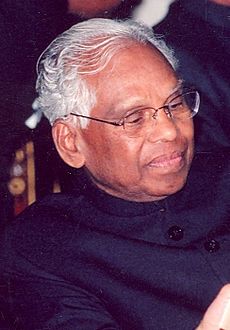
Kocheril Raman Narayanan
| 10th President of India | |
|---|---|
| In office 25 July 1997 – 25 July 2002 |
|
| Prime Minister | I. K. Gujral Atal Bihari Vajpayee |
| Vice President | Krishan Kant |
| Preceded by | Shankar Dayal Sharma |
| Succeeded by | A. P. J. Abdul Kalam |
| 9th Vice President of India | |
| In office 21 August 1992 – 24 July 1997 |
|
| President | Shankar Dayal Sharma |
| Prime Minister | P. V. Narasimha Rao Atal Bihari Vajpayee H. D. Deve Gowda I. K. Gujral |
| Preceded by | Shankar Dayal Sharma |
| Succeeded by | Krishan Kant |
| Personal details | |
| Born | Kocheril Raman Narayanan 4 February 1921 Perumthanam, Travancore, British India (now Uzhavoor, Kerala, India) |
| Died | 9 November 2005 (aged 85) New Delhi, India |
| Nationality | Indian |
| Political party | Indian National Congress |
| Spouse(s) | Usha Narayanan (m. 1951–2005) |
| Children | Chitra Narayanan Amrita Narayanan |
| Alma mater | University of Kerala (B.A., M.A.) London School of Economics(B.Sc) |
| Signature |  |
Kocheril Raman Narayanan (27 October 1920 – 9 November 2005) was the tenth President of India.
Born in Perumthanam, Uzhavoor village, in the princely state of Travancore (present day Kottayam district, Kerala), and after a brief stint with journalism and then studying political science at the London School of Economics with the assistance of a scholarship, Narayanan began his career in India as a member of the Indian Foreign Service in the Nehru administration. He served as ambassador to Japan, United Kingdom, Thailand, Turkey, People’s Republic of China and United States of America and was referred to by Nehru as “the best diplomat of the country”.[1] He entered politics at Indira Gandhi’s request and won three successive general elections to the Lok Sabha and served as a Minister of State in the Union Cabinet under former Prime Minister Rajiv Gandhi. Elected as the ninth Vice President in 1992, Narayanan went on to become President in 1997. He was the first member of the Dalit community to hold the post, and the only one until Ram Nath Kovind was elected in 2017.
Narayanan is regarded as an independent and assertive President who set several precedents and enlarged the scope of the highest constitutional office. He described himself as a “working President” who worked “within the four corners of the Constitution”; something midway between an “executive President” who has direct power and a “rubber-stamp President” who endorses government decisions without question or deliberation. He used his discretionary powers as a President and deviated from convention and precedent in many situations, including – but not limited to – the appointment of the Prime Minister in a hung Parliament, in dismissing a state government and imposing President’s rule there at the suggestion of the Union Cabinet, and during the Kargil conflict. He presided over the golden jubilee celebrations of Indian independence and in the country’s general election of 1998, he became the first Indian President to vote when in office, setting another new precedent.
K. R. Narayanan was elected to the Presidency of India (17 July 1997) with 95% of the votes in the electoral college, as a result of the Presidential poll on 14 July. This is the only Presidential election to have been held with a minority government holding power at the centre. T. N. Seshan was the sole opposing candidate, and all major parties save the Shiv Sena supported his candidature., while Seshan alleged that Narayanan had been elected solely for being a Dalit.
Latest Govt Job & Exam Updates: